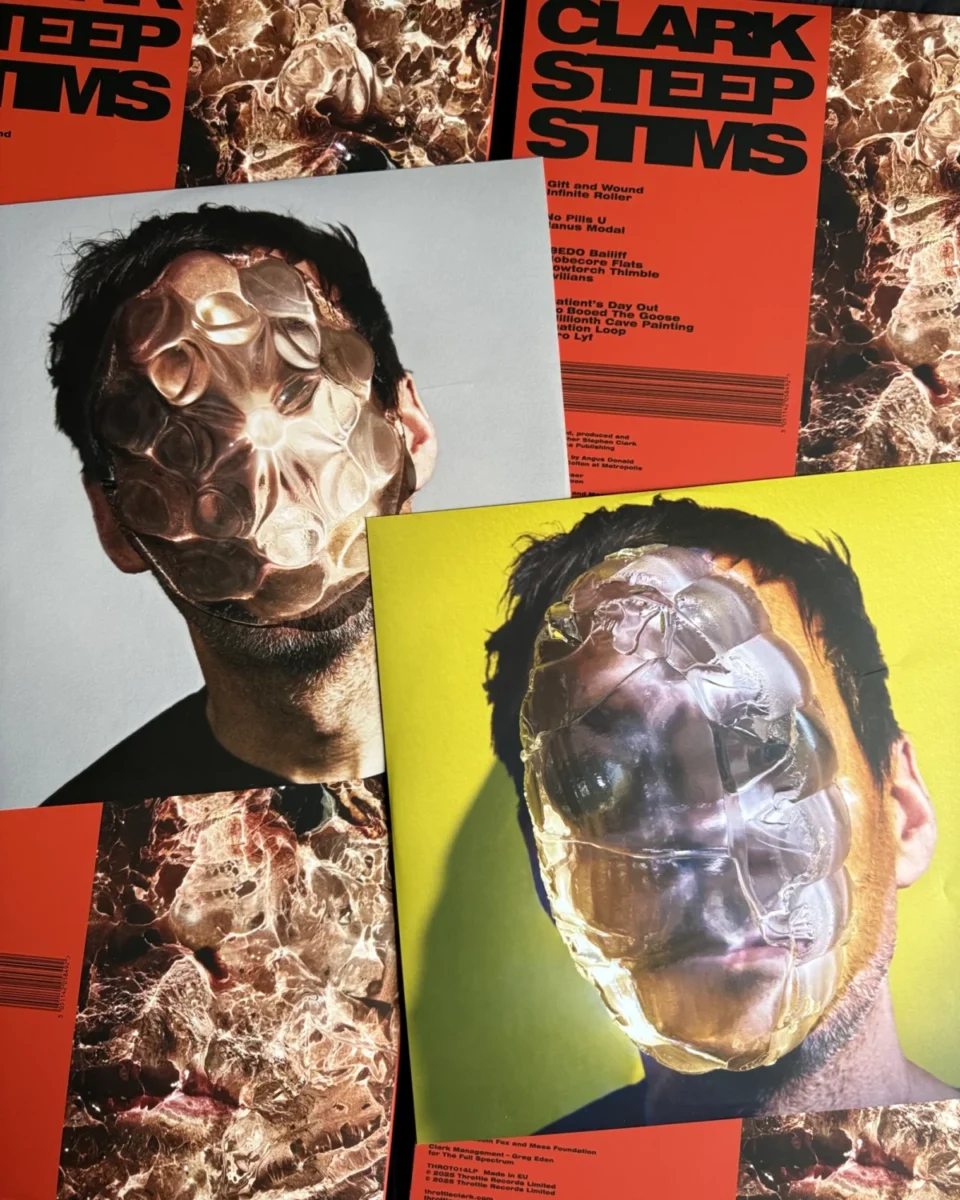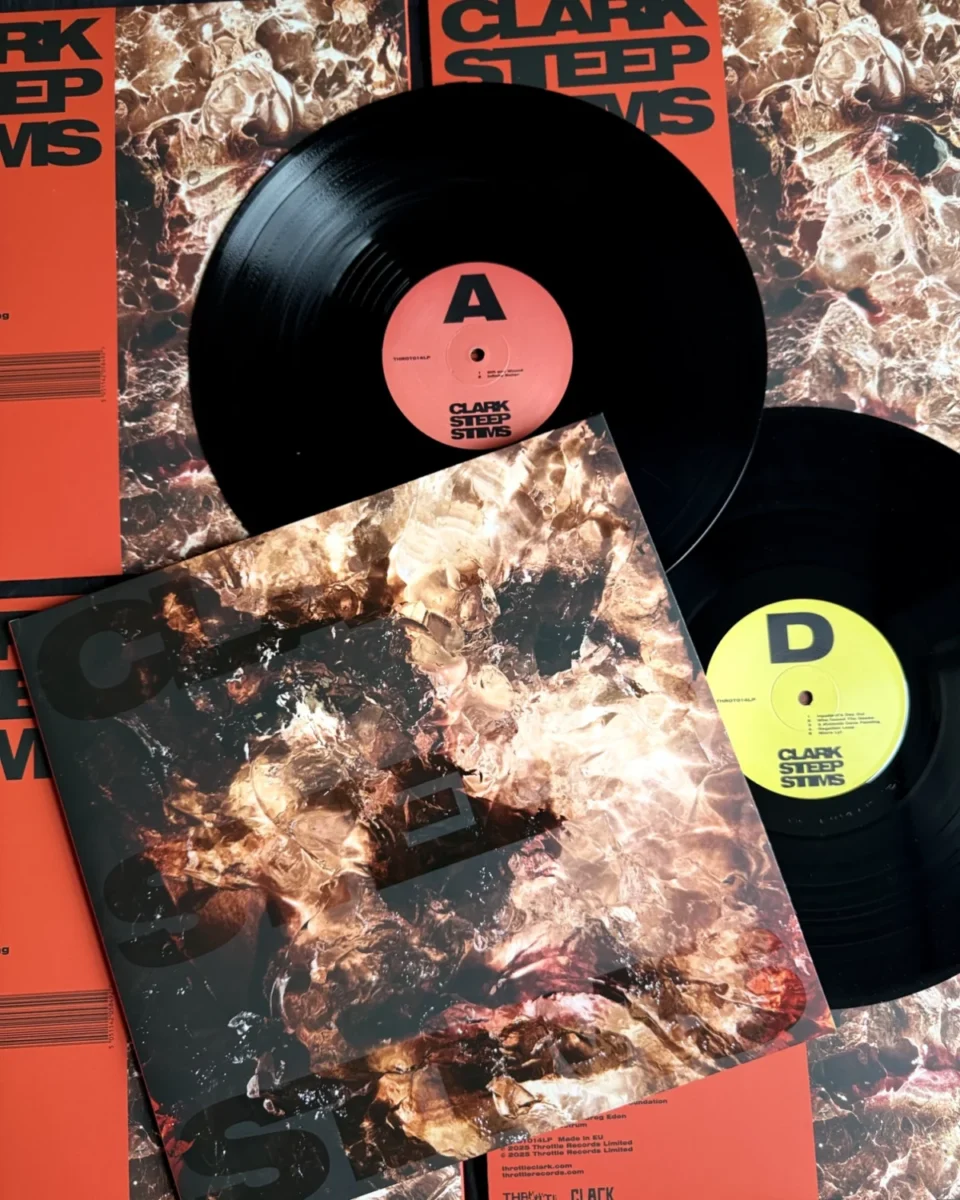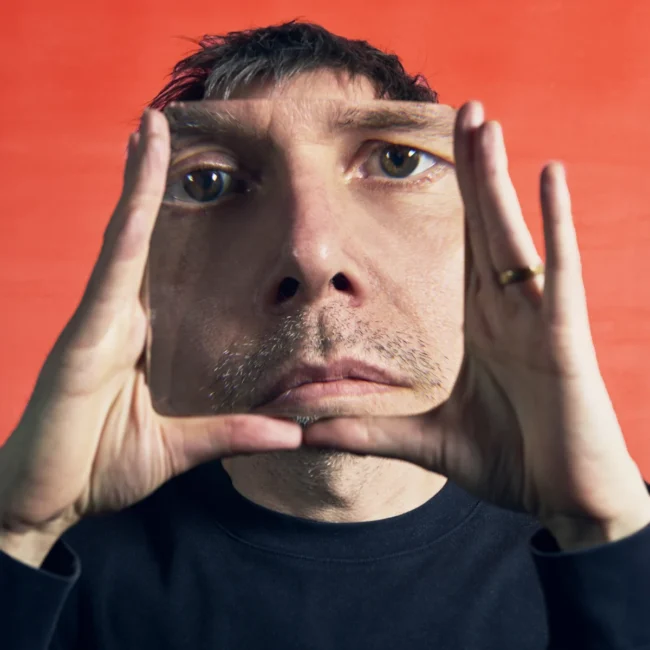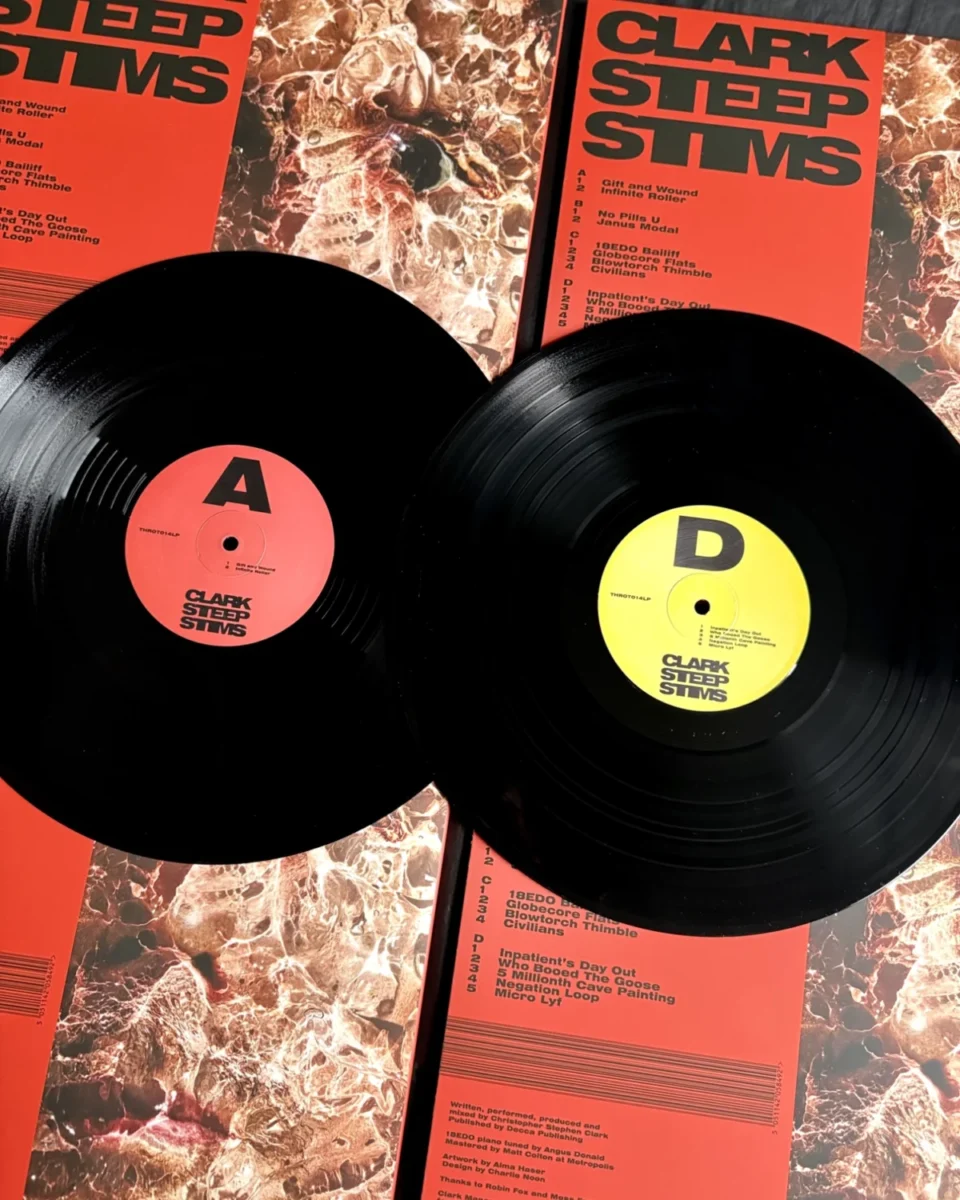Steep Stims marks something of a return for Clark. After forays into Thom Yorke’s school of a vocally-injected kind of IDM, as well as a number of full-length soundtrack LPs, the endlessly industrious producer drops a record that would fit snugly on the Warp Records shelves. A spot Chris Clark would, in the label’s golden age, have felt very much at home as he established himself as a mainstay there, alongside the likes of Plaid, Squarepusher, Aphex Twin, Boards Of Canada, Autechre, et al.
But despite inevitable experimental leanings, Steep Stims is heavily rooted in dancefloor aesthetics; it’s a record that, despite all its intricacies, feels crafted to be heard, in its heavier and more dramatic moments, in a strobe-slashed woodland or cavernous dripping basement. Indeed, a recent live set at Draaimolen received wide praise whilst tapping into the productions found on the album.
Released on Clark’s own Throttle Records, Steep Stims sprawls languidly across genre boundaries, utilising reverb-drenched trance arps, off-kilter piano and DnB workouts, and lush electronica soundscapes, all shot through with an irresistible sensation of 90s nostalgia that both recalls the earlier productions such as Clarence Park, and threads a coherent path through this delightfully chaotic sonic maze of mirrors.
Our first interaction with the album consists of the dancing, interweaving synth lines that build that big-room trance tension, before “Gift and Wound” climaxes with huge distortion and sonic texture, which hits as hard as any percussion sample might. As quickly as it begins, the track quickly fades on a bed of gentle pads. “Infinite Roller” begins with a simple 4/4 kick and more of those playful synth lines, some almost building like a brass section. A groovy, slightly moody number that, aptly, rolls along in a trippy, if only gently, manner, more of those harder, reverb imbued trance lines hint in the background at what is to come. And it’s at the halfway mark that the train takes the darker fork in the line, chord stabs puncturing the earlier serenity of the wistful, playful little sonic bubble.
Third track No Pills For U feels straight out of the Warp playbook; it’s more of the trancey, almost flutelike synth lines and delicate melodies that have shades of work from a certain Cornish producer…”Janus Modal” feels as though the sketch of No Pills is filled out, skittering percussion and those same distorted synths building unbearable, knife-edge tension, before a silence is filled with rushing hats and delicate melodies, all undercut by deep, rich, bass chord progressions. It’s a track that represents the best of the constantly evolving, naturally progressive nature Steep Stims. Barely a bar is repeated across 7 minutes of intricately sequenced, rapturous club tackle, and yet it draws the listener’s ear irresistibly.
Suddenly, we find ourselves plunged into the jangly piano workout of 18EDO Baillif, an ominous, stumbling, cinematic soundscape that, just as it begins to fade out, is undercut by my favourite surprise on the album. As we seamlessly transition into “Globecore Flats”, that same piano motif finds itself undercut by a two-stepping little DnB sequence, conjuring a somehow awkward-yet-captivating groove. Throw in enormous slabs of distorted bass and that groove morphs into white hot burner – just enormous fun to listen, and move, to.
“Blowtorch Thimble” continues the trend of shit-eating grin chaos, all tech step rhythms, racing synth lines and a high, tubular synth plonking a melancholy melody above it all. At the break that racing synth takes centre stage before the track transitions into a 4/4 pulse replete with squelching acid lines, breathlessly racing into more unhinged breaks and trancey synth stabs. Chaos distilled into a pure 3 and a half minutes.
This utter chaos is followed up with “Civilians”. An exercise in pure wonk, a stomping little broken beat number, flutey synths juxtaposed against a growling little bassline. It goes panting, squelching along, its off-kilter sampling and stumbling rhythms leading to a finish line of mischievous arps.
Clark’s own description of In Patient’s Day Out is “some sort of Morricone-does-kraut-rock-with-drum-machines”, although possibly just in his own imagination. However, the interweaving, whimsical little synth melodies, the very 90s drum sequencing and sighing, almost-vocal samples gliding through into the foreground, it kind of makes sense. A new sub-genre in the making perhaps.
“Who Booed the Goose” picks up the same synth lines that In Patient left off with, and turns up the drama into a burning, building crescendo of sound. Sheer spectacle that fades into delicate dripping quiet. From this quiet comes the brief interlude of brooding, heavily reverbing and echoing synths, growling lows and cavernous mids of “5 Millionth Cave Painting”.
Following this snippet comes the same synths but sharper, more blindingly colourful, as the trance breakdowns of “Negation Loop” amplify the yearning vocal samples from, presumably, the man himself. Here Clark really makes the Virus synthesiser (which features on virtually every track) scream into the blackness, and when the dust settles the track is gently guided back to earth in all its falsetto splendour.
The album finishes with “Micro Lyf”, more rushing synths over a barely discernible, metronomic kick, key changes and chord progressions building to crescendo then giving way to soft, luscious pads and chimes. That kick becomes deeper, heavier, a pounding heartbeat at the centre of the softness before the track, and the album, dissolves into a rumble of apocalyptic low-end noise, and eventually silence.
Interview by Tom Durston & Will Patterson

"Steep Stims is a shorthand way of conveying all of this in two crisp words, the code of techno/rave music. It contains all my influences, the producers I love, blurred and refracted through my path."
Hi Chris, congratulations on the release of your new album Steep Stims. It spans such a wide range of moods, textures and intensities – from dreadnaught bass and D&B breaks to field recordings and trance-leaning synths – all filtered through that unmistakable Clark palette. What’s the story behind the album and the title Steep Stims?
It’s about passion, something being at stake, a steep climb, but that’s a bit much when stated plainly. It’s just an album! So, I wanted to undercut that a bit, the seriousness of it, with something self-effacing, I find this tension interesting, generative – literally like the artwork. I look like I’m barely held together. Stims just means stimulating, or stimming, repeating, iterations, obsession.
Steep Stims is a shorthand way of conveying all of this in two crisp words, the code of techno/rave music. It contains all my influences, the producers I love, blurred and refracted through my path.
I’ve been listening to Steep Stims while running through forest trails in deep autumn – copper leaves dropping everywhere – and it feels incredibly fitting. The melancholic piano work in “Globecore Flats” and the breaks-driven moments feel like emotional peaks. When did you begin the record, where was it produced, and what atmospheres or emotional terrain were you exploring?
Copper is decent, a lovely colour. I produced most of it at home, some of it on a laptop on train journeys and most of the initial ideas came from working at MESS in Melbourne, a synth workshop place run by my friend Robin Fox, a lovely man. Emotional terrain – I try and aim for not specific emotions but many feelings, a record rich in feeling. Emotions are kinda heady neurotic things, full of thought and rumination-music is an escape from this for me – feeling for me is the thing, your whole body reacts so listening on headphones whilst running sounds perfect, the intricacies of music feel beamed directly into your body.
When I’m away from actually creating it, I spend time a lot of time ruminating, thinking probably too much, endless back and forth about the structures of the work but the real catharsis is when I forget all of that, feel my way into it in a way beyond language/procedures. It’s like asking a cat why it enjoys lying in warm places – making music for me is like this. It’s my favourite place to be and frustrating for people baffled about what I get from it-I can’t give any rational reason for why I do it.
But the arc of the album is the thing that takes a while, the last third – this was kinda written as one long 15-minute track. Once I had that – and the first two tracks, it felt like it was sorta probing itself into existence. Even the tough quite aggro bits-there’s this weird clarity you get. At times I felt so relaxed putting it together.
There’s a playful, almost whimsical streak throughout the album – it doesn’t feel overly self-serious, even when it hits heavy. Can you walk us through your creative process for this one?
Playful-essential. It’s funny innit – we want music because words and language doesn’t really fully work for us, can never fully satisfy. Partly because language on the surface makes too much sense. Really, it’s just a bunch of noises we mouth at each other. But albums can never quite be pinned down. So, it’s like serious play – it’s a really serious thing if you wanna get good at it.
But I howl with laughter at too much self-seriousness in music and then feel a bit guilty, because people should just let loose, feel free and not feel self-conscious. And one person might have a complete opposite experience of that to another. Brutally sad, uncanny music, I never feel sad when I make it, or listen to it. I feel light, a bit excited, engaged.
Self-consciousness is also killer – it’s best to forget it. Confidence too, is almost like a lame version of clarity and often kinda masks its opposite which no doubt is often simmering under the surface. I guess I believe in this thing of being ultra serious about music in pragmatic terms, i.e. working it, working it hard, like long days where you just can’t pull away from it.
But when it’s more difficult or not rewarding, or I can’t see a way out, I have this hack “don’t blame music, it’s not poor old music fault” or I start finding it funny “ffs stop taking this so seriously it’s just music” I’ll have a quick break and then ironically I can then carry on taking it seriously. I seem to push through and find something that interests/excites me.
Music tends to get better the deeper you go into it, you can never quite complete it. This spurs me on. It’s like science and dreamworld combined. It grounds me and gives my life form. Maybe because I don’t come from a musical background at all, and I’m self-taught, largely, it’s always seemed to me more a gift than a chore, something I feel grateful about.
I love the fact that you used the Virus synth on all the tracks, and with that comes the element of 90s nostalgia throughout that really shines through. Did you come into the studio with an idea of how the record would sound and the directions it would take? Or did the process kind of take over itself and dictate the final product?
Honestly it started in MESS – they have all these posh amazing old synths from the 70’s. But the Virus was kind of winking at me, looking a bit unloved in the corner. Literally the first thing I made on it was the riff from “Blowtorch Thimble”. Most of the record started from that. It has a lovely thing going for it-like it’s old but also seems to hint at the hyperpop realm that was/is a more popular form now, but it’s not like it came out of nothing-despite what marketing tells us-to me it’s like a cleaned up purely digital laptop version of huge late nineties trance riffs.
I don’t mind that sound at all, not negging on it, it can be a thrill-but I find it problematic- how unproblematic it is-like so frictionless and instantly loud and massive and slick straight out of the laptop. The Virus, because you have to use line outs and commit to recording, it’s a bit clippy as well, you have to work it a bit more, I used tape and pedals to kinda burnish it, it feels sanded down, the fizz attenuated by analogue processing.
So, the approach-same with the Korg Kronos-when you tape it up or degrade the signal it feels uncanny and you fall into the sound of it more, rather than it being explicitly retro in that cosy familiar way.

"Music tends to get better the deeper you go into it, you can never quite complete it. This spurs me on. It’s like science and dreamworld combined. It grounds me and gives my life form."
You mentioned you “had to remove yourself from the stims and stop enjoying the process.” What does that mean for you? Was there a danger that the record could become endless if you didn’t step away?
Ha yea totally. The Stims are a secret weapon but can also be a producer’s kryptonite. You can endlessly go into a specific sound, it’s like ear training, judging the diff qualities. I’d really recommend it but also I have to be a bit careful. You can lose sight of the feelings you’re revealing. “Feelings “ sounds a bit dumb, but that’s really what it is. Like the end of “Negation Loop”.
When I came up with that, I knew I had the feeling of it, I can’t explain why, it wasn’t planned it just sort of formed itself, cut a compelling shape. I understood instinctively how many cycles, why the pitch on the vocal worked, the nod to William Basinski in how it crumbles to offset the bombast of the previous section etc. It just “felt” right very quickly. I didn’t need to work it too much. It’s only now in retrospect that I’m giving it the shine of me “knowing” why it worked, but it’s not knowledge at all, it’s intuition/understanding.
But because I was enjoying some of the other songs so much, like “Janus Modal”, they were harder to pin down, like slippery eels. I eventually just went with an earlier incarnation, there was like 2 hours of it to edit down or something.
You’ve spoken about working predominantly with hardware – the Virus, plus older gear with limited memory capacity, chasing that early-sampler spirit. Now that you move fluidly between hardware and software, how do you see the strengths of each? Does one spark more inspiration?
I really don’t reflect on this stuff much at all so it’s hard to say. I’m not really a gear head, I tend to just get very focused on what I have in front of me, I think partly out of stubbornness, I don’t want to be reliant on a particular method.
Saying that-I’ve realised I find such comfort in particular synths, like the Siel. It’s just a go to for it’s naff piano sound, but it’s so brown/orange, it’s the most brown / orange thing I’ve ever heard. It will never not feel good to play it.
I love what I can do with my computer, I feel like I can do anything-in a way I can do too much. So maybe the computer can trigger overwhelm for some people? I don’t personally feel that. This doesn’t put me off because I tend to obsess about a few things it can do and kinda burrow into them. I don’t need to know literally everything-all the software etc.
Actually, I kind of do, I’m bullshitting myself a bit here. Intuition is the coin of the realm-conscious knowledge that never gives you intuition out of nowhere. It can be absorbing and helpful, but also a cold path if you have nothing to say.
This record reconnects with the spirit of Clarence Park (2001) – working fast, embracing limitations. What did returning to that mindset unlock for you artistically?
Just the non-serious / serious thing maybe? The rush of first love. I’d rather have an album with an arc, contrast, vivid colour and the occasional moment of total devastation, sadness, euphoria, the whole gamut-rather than an album of homogenous kinda restrained “tasteful” generic melancholy.
I like a targeted approach and getting out as soon as I can once I’ve said my piece kinda thing. For me that feels like a more appealing way to use control/restraint. But of course different strokes for diff folks. The idea of a Rothko but for music – just one thing done again and again. Ofc that’s a thing too.
Were there any artists, labels, environments, mediums, films or scenes feeding into your headspace while making the record? Or is this very much a self-propelled orbit – an internal evolution within the Clark universe?
Weirdly my taste in film / books isn’t very “electronic music” I’m not that into SF. I have this idea I should be though. Although a friend has recently been getting me into Iain M. Banks.
I recently read Roadside Picnic and loved it. But more than SF, it’s so Russian, the unhinged dialogue, the non sequiturs, the willingness to go to some pretty dark but hilarious places. It’s almost like a reverse frontier myth.
The aliens came to earth and instead of colonising it-they just leave because they find it boring. But then it deals with the human motivation to colonise that evacuated space. They’re the ones, not the aliens, that have a need to conquer and assert dominance, the greed masks their frailty, which they cannot deal with.
It gives them a scheme. So, they colonise this dangerous “other” space and the results are evil and tragic. How this relates to my music I don’t know. I don’t tend to transplant what I read into my music literally, it would feel self-conscious-but it’s all there, whirring away in the chamber somewhere.
We heard incredible things about your live set at Draaimolen Festival – people were still talking about it afterwards. How much of Steep Stims made it into that performance, and how did you approach preparing for a forest-rave setting like that? Any particular moments that felt especially magical or chaotic in the best way?
Ah thank you. I was so happy be asked to do it. I’ve been a fan of Blawan for about 14 years now-such a great thumbprint in his sound, the maddest of productions. His new record is killer. The sound at Draaimolen was so good. It was a wild place to introduce some of the record.
Preparing for the forest there was no prep for that, the setting was idyllic – but I’d come from a long flight from Australia so my sleep was a bit messed up – I was thinking I’d be radgy and not up for it as I’d just been making loads of spoken word and piano music, but the sound and people jolted me out of that. The sound system was so crisp and dry, you could hear everything.

"Intuition is the coin of the realm-conscious knowledge that never gives you intuition out of nowhere. It can be absorbing and helpful, but also a cold path if you have nothing to say."
What were your impressions of Draaimolen as a festival, and how did you feel hearing about the uncertainty around its future and the venue situation?
I haven’t heard anything about this but if it’s not happening again-this would be a real shame.
Zooming back to the record – where do you feel Steep Stims sits within your catalogue? Does releasing on your own Throttle label give you a different sense of creative freedom compared to your Warp years?
Maybe sits with my self-titled record on Warp. I tend to see linkages where other people don’t and vice versa. It’s def positive putting it out on Throttle. You say creative freedom heheh I def have this, but you tend to end up with piles of music with too much freedom-it would drive me mad.
Being able to curate an album, put a boundary around it- making it a *thing* it’s my mission in life really. Writing loads of tracks is easy but the album to me is still where it’s at. So much of it is shades of colour-like Inpatients Day Out. It’s kind of a kosmische / kraut thing maybe wouldn’t be out of place on Body Riddle. I’ve got quite a few pieces from a similar zone.
Two tracks like that on Steep Stims. Get out of here! Would be stylistically confusing. But one is good, it’s like a zingy shift in palette. So those decisions-they’re still creative but it’s not “writing music” per se. It’s more like directing / curating. And Throttle Records gives me a chance to work that muscle on other people’s music as well.
The artwork has such a striking, textural, collage-like feel. Can you talk about the visual direction and how it connects with the album’s themes and energy?
I’ve loved Alma Haser‘s work for over 10 years now. It’s so simple, her use of jelly for the cover – at first you’re like “eh?”. But she’s super committed to it and the results prove it. I find the images she creates confounding; they please my eyes so much. It sits in this zone of real world / visceral / abstraction without using digital trickery.
What really appeals is the use of a simple formula that creates these madly deep / complex results. It’s addictive, like music. She’s a fellow person of the Stims so we relate. She just stubbornly will not stop until she finds it. Inspiring.
Having revisited early, spontaneous ways of working, do you see this approach as a one-off burst, or the beginning of a new chapter in your creative process?
Honestly no idea. I’m open to possibilities. Fundamentally I just wanna make more work. I enjoy releasing it.
Finally, what do you hope listeners carry with them after experiencing Steep Stims?
Haha that’s so hard to answer! I don’t wanna steer it. When I think about discovering music I love, I rarely care that much about what the artist intended. It’s a private moment, or moment with friends. I’m just happy people can listen to it, and that some people seem to really want to listen to it. FFS that’s a bit of a boiler plate mainstream guy promoting something on a podcast answer. Part of the enjoyment is letting go though, it’s in the world now. Exciting.
‘Steep Stims’ is out now via Throttle Records. Buy vinyl from Inverted Audio Record Store.
Portrait Photos by Alma Haser
Product Photos by Tom Durston
A1. Gift And Wound
A2. Infinite Roller
B1. No Pills U
B2. Janus Modal
C1. 18EDO Bailiff
C2. Globecore Flats
C3. Blowtorch Thimble
C4. Civilians
D1. Inpatient’s Day Out
D2. Who Booed The Goose
D3. 5 Millionth Cave Painting
D4. Negation Loop
D5. Micro Lyf


